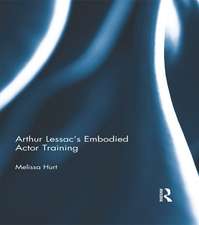Physical Expression on Stage and Screen: Using the Alexander Technique to Create Unforgettable Performances
Autor Bill Conningtonen Limba Engleză Paperback – 18 iun 2014
Preț: 166.36 lei
Preț vechi: 206.19 lei
-19% Nou
Puncte Express: 250
Preț estimativ în valută:
31.83€ • 34.04$ • 26.54£
31.83€ • 34.04$ • 26.54£
Carte disponibilă
Livrare economică 27 martie-10 aprilie
Preluare comenzi: 021 569.72.76
Specificații
ISBN-13: 9781408182642
ISBN-10: 1408182645
Pagini: 200
Dimensiuni: 156 x 234 x 13 mm
Greutate: 0.36 kg
Editura: Bloomsbury Publishing
Colecția Methuen Drama
Locul publicării:London, United Kingdom
ISBN-10: 1408182645
Pagini: 200
Dimensiuni: 156 x 234 x 13 mm
Greutate: 0.36 kg
Editura: Bloomsbury Publishing
Colecția Methuen Drama
Locul publicării:London, United Kingdom
Caracteristici
Written by the best-selling coauthor of The Alexander Technique, published by HarperCollins in 1990, this book will update the technique for the contemporary reader.
Notă biografică
Bill Connington has devoted his career to helping performers-including Broadway actors, Metropolitan Opera singers, and renowned instrumentalists-manage their art through managing themselves. The former chairman of the board of the American Center for the Alexander Technique, Bill is currently a lecturer in acting at the Yale School of Drama and has taught performers at NYU's Tisch School of the Arts, the Juilliard School, and the Actors Studio MFA Program.
Cuprins
A Note on the ExercisesIntroductionPART ONE Preparing YourselfChapter 1 The Alexander Technique and Theater TrainingChapter 2 Sensory AwarenessChapter 3 Poise, Flow, and ChoiceChapter 4 The Use of Your SelfChapter 5 Changing Your Mind-BodyChapter 6 BreathingPART TWO Organic ExpressionChapter 7 Using Your ImaginationChapter 8 Conscious Imitation of OthersChapter 9 Using Voice and Movement to Stimulate the Mind-BodyPART THREE Putting It All TogetherChapter 10 Auditions, Rehearsals, and PerformancesChapter 11 Your Psycho-Physical Health and ChoiceTextual ReferencesAcknowledgmentsIndexExercise VideosContact
Recenzii
A clear, detailed, and practical account of how the Alexander Technique can help liberate performers from habitual psychophysical tensions, allowing them to access the deepest and most creative impulses in their work.
In small, doable steps, Bill guides the actor toward a healthy, creative life as a performer-always with a supportive, encouraging tone and attention to process as opposed to results.
Bill Connington writes with insight, clarity, and flair about a subject he loves and shares his valuable perspective on the training of actors by exploring the all-important connection between body, mind, and spirit. In a voice both friendly and knowledgeable, Physical Expression on Stage and Screen guides the actor from class to rehearsal to performance.
Physical Expression on Stage and Screen provides new insight into the Alexander technique, which was pioneered by F. M. Alexander in the late 1800s . The best part of the book is the exercises (more than 100) that help actors explore their unique styles. Many of the exercises are also supported by free online videos created by the author. This no-nonsense explanation of the Alexander technique is accessible to untrained students and a good refresher for those knowledgeable about acting. Summing Up: Highly recommended. Lower-division undergraduates through faculty and professionals
In small, doable steps, Bill guides the actor toward a healthy, creative life as a performer-always with a supportive, encouraging tone and attention to process as opposed to results.
Bill Connington writes with insight, clarity, and flair about a subject he loves and shares his valuable perspective on the training of actors by exploring the all-important connection between body, mind, and spirit. In a voice both friendly and knowledgeable, Physical Expression on Stage and Screen guides the actor from class to rehearsal to performance.
Physical Expression on Stage and Screen provides new insight into the Alexander technique, which was pioneered by F. M. Alexander in the late 1800s . The best part of the book is the exercises (more than 100) that help actors explore their unique styles. Many of the exercises are also supported by free online videos created by the author. This no-nonsense explanation of the Alexander technique is accessible to untrained students and a good refresher for those knowledgeable about acting. Summing Up: Highly recommended. Lower-division undergraduates through faculty and professionals










